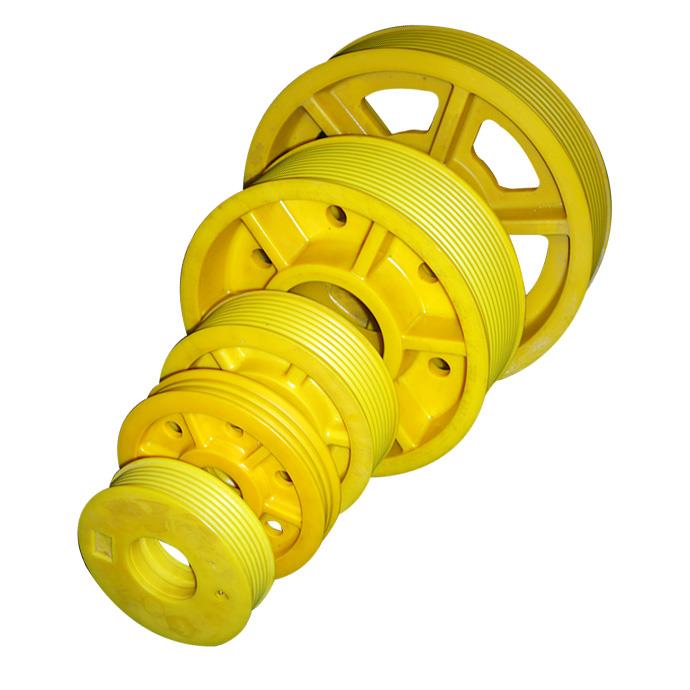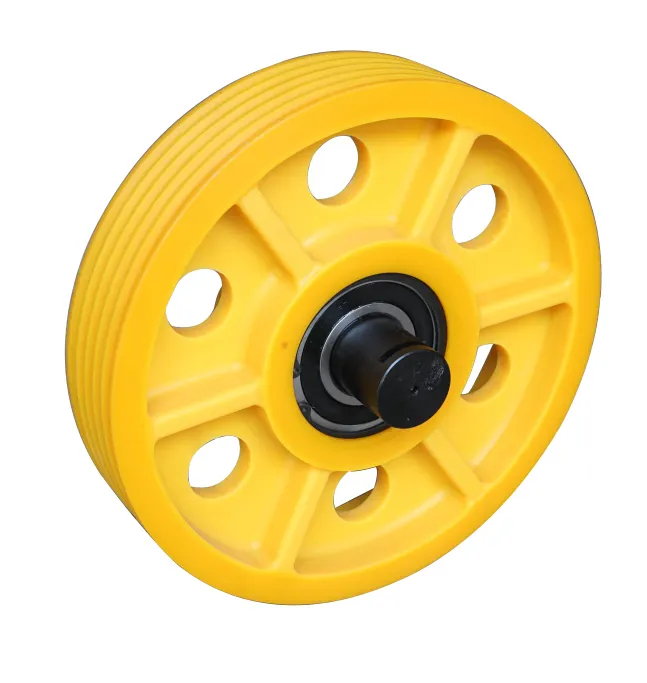Product Description
Mine Hoist Xihu (West Lake) Dis. Pulley for Mining Lifting Equipment
Product Introduction:
Xihu (West Lake) Dis. wheel device can transport the whole under the premise of swimming round and fixed wheel adopts integral cast joint structure, wheel hub, wheel rim for cast steel materials, spoke for the channel steel, after welding the whole annealing process again.
Considering the replacement bearing maintenance convenient, leave replace bearing remove space, guide wheel device structure adopted eccentric layout.
Xihu (West Lake) Dis. shaft using middle carbon alloy steel forging whole, adopting the structure of the cast joint pulley, equipped with PVC or nylon liner, protect the wire rope.
Imported or domestic spherical roller bearings, also can install bearing temperature measuring element.
In order to prolong the service life of wire rope, rim inside wedge liner with wear-resisting, withstand voltage, using D660 (1571) or nylon liner.
1) eccentric layout: on 1 side of a winding wheel have replaced bearing dismantling space, can not remove the pulley mechanism, only for bearing maintenance and replacement.
2) symmetry layout: relative with 4 wheels on both sides of the 2 bearing seat is symmetrical, but need to replace the bearing shell, only to remove the pulley mechanism.
sheave pulley and the common malfunction and technical guide wheel
1) to the problem of old structure pulley sliding bearing to burn tile should improve lubrication way; Because of the pulley is installed on the derrick, daily maintenance inconvenience, should add temperature alarm device, so as to timely maintenance to prevent the tile burning failure, or the original sliding bearing replacement into rolling bearing structure
2) for old structure pulley rope groove without liner, can no longer add padding on the original rope groove, need to change a gasketed pulley, adjacent assembly size can remain motionless, and installation
3) for mountain transportation difficulties or have some difficulties in roadway transportation in underground mine, the pulley is (guide wheel) change the structure into 2 or 4 and a half of head sheave.
Mine hoist sheave specification:
| Material | Q235B,Q345B,35#,45# |
| Heat treatment | Hardening and tempering, high frequency quenching, carburizing quenching and so on |
| Groove surface quench | HRC45-55 |
| Groove surface quench depth | ≥2mm |
| Processing diameter scope | 1600~5000mm |
Our services:
1>.Pre-sale services: enthusiasm
We provide you with the prophase plan, process flow design and manufacturer equipment according to your special demand.
2>.Sale services: servant
Send technicians to the jobsite for guiding the installation and adjustment, training operators and finishing the check and accept together with you.
3>.After-sale services: faithfulness
To establish long term friendship, we will regularly pay return visit to customers.
Supplying technique, building design, instruction, installation and debugging for free.
4>.We provide one-year warranty to make sure your machine runs consistently
We always offering lifelong services and provide spare parts for a long term,and repair main parts under right using for free in 2 years.
About us
CITICHL is national major industry and heavy machinery manufacturing base in the middle of china, we can supply the customers with important complete technical equipments in mining, non-ferrous metal, chemical industry, metallurgy, construction materials, environment protection, and power generating as well as other basic industries. Our products are sold well to countries and regions in Asia, Africa, Europe, and Australia, and hold a large market share home and abroad.
We also supply all kinds of crushing equipments, vibrating feeder, vibrating screen, rod mil, stone washer, belt conveyor, screw classifier, flotation machine, magnetic ore separator, shaving table, spiral chute, rotary kiln, rotary dryer, mine hoist , ect. If you have any interest in our products, pls kindly contact us by the upper information with no hesitation.
| Type: | Electric Winch |
|---|---|
| Driven Type: | AC |
| Speed: | Fast |
| Carrying Capacity: | Weight Level |
| Tonnage: | 10T |
| Reel Number: | 1/2 |
| Customization: |
Available
| Customized Request |
|---|
Can lifting pulleys be upgraded or retrofitted into existing lifting systems?
Yes, lifting pulleys can be upgraded or retrofitted into existing lifting systems to improve their performance, efficiency, and safety. Upgrading or retrofitting lifting pulleys offers several benefits and allows for the integration of new technology and advancements. Here’s a closer look at the process and advantages:
1. Assessment of Existing System: Before considering an upgrade or retrofit, it is important to assess the existing lifting system. Evaluate the condition of the pulleys, cables, ropes, and other components. Determine if any components are outdated, worn, or no longer meet the requirements of the lifting operation.
2. Identifying Improvement Opportunities: Identify the areas where the lifting system can be improved. This can include enhancing load capacity, increasing efficiency, improving load control, reducing maintenance requirements, or enhancing safety features.
3. Consulting with Experts: Seek advice from lifting equipment specialists or engineers who have expertise in upgrading or retrofitting lifting systems. They can provide valuable insights and recommendations based on their knowledge and experience.
4. Selection of Upgraded Pulleys: Select lifting pulleys that align with the specific requirements and improvement goals of the existing lifting system. Consider factors such as load capacity, efficiency, load control features, durability, and compatibility with the existing system.
5. Installation and Integration: Install the upgraded pulleys into the existing lifting system. Ensure that the installation is carried out by qualified personnel following the manufacturer’s guidelines and safety procedures. Integrate the new pulleys seamlessly with the existing components, such as cables, ropes, and attachments.
6. Testing and Performance Evaluation: Conduct thorough testing and performance evaluation of the upgraded lifting system. Verify that the new pulleys meet the desired improvements in terms of load capacity, efficiency, load control, and safety. Address any issues or adjustments that may arise during the testing phase.
7. Training and Familiarization: Provide training to operators and maintenance personnel on the proper usage, maintenance, and safety precautions related to the upgraded lifting pulleys. Ensure that they are familiar with any new features or functionalities introduced by the upgrade.
8. Maintenance and Regular Inspection: Establish a maintenance schedule for the upgraded lifting pulleys and associated components. Regularly inspect and maintain the pulleys to ensure their optimal performance and longevity. Follow the manufacturer’s recommended maintenance procedures.
By upgrading or retrofitting lifting pulleys into existing lifting systems, organizations can leverage the benefits of modern technology and advancements without the need for a complete system overhaul. This approach enhances the efficiency, performance, and safety of the lifting operations, ultimately improving productivity and extending the lifespan of the lifting system.
What are some real-world examples of lifting pulley applications in construction projects?
Lifting pulleys are widely used in construction projects for various lifting applications. They enhance the efficiency and safety of lifting heavy loads, equipment, and materials. Here are some real-world examples of lifting pulley applications in construction:
1. Tower Crane Lifting: Tower cranes are commonly employed in construction projects to lift and move heavy materials and equipment vertically and horizontally. These cranes utilize lifting pulleys in their lifting mechanisms. The pulleys distribute the load’s weight, provide mechanical advantage, and enable precise control over the lifting process.
2. Mobile Crane Operations: Mobile cranes, such as truck-mounted or rough-terrain cranes, are versatile lifting equipment used in construction sites. Lifting pulleys are integral components of these cranes, specifically in their boom systems. The pulleys help lift heavy loads and position them accurately, facilitating efficient construction operations.
3. Elevator Installation: In construction projects involving multi-story buildings, elevators are essential for vertical transportation. Lifting pulleys are crucial components in elevator systems. They enable smooth and controlled movement of the elevator car, ensuring safe transportation of passengers or goods between floors.
4. Concrete Pumping: Concrete pumps are used to transport and pour concrete in construction projects. These pumps employ lifting pulleys to lift and position heavy concrete-filled hoses or booms. The pulleys facilitate precise pouring and placement of concrete, allowing for efficient construction processes.
5. Roofing Material Installation: Lifting pulleys are commonly used in construction projects for the installation of roofing materials. They assist in lifting heavy roofing materials, such as shingles or metal panels, to elevated locations. The pulleys help distribute the load’s weight and make it easier for workers to handle and position the roofing materials accurately.
6. Facade Installation: Lifting pulleys play a crucial role in the installation of building facades. They are used to lift and position large panels, glass sheets, or curtain wall components to the desired heights. The pulleys enable controlled movement and precise placement of the facade elements during installation.
7. Bridge Construction: Lifting pulleys are extensively utilized in bridge construction projects. They assist in lifting and positioning heavy bridge components, such as segments, beams, or precast elements. The pulleys distribute the load’s weight and enable precise control over the lifting process, ensuring safe and efficient bridge construction.
These are just a few examples of how lifting pulleys are applied in construction projects. Lifting pulleys offer versatility and adaptability, allowing them to be customized and integrated into various construction lifting systems. By incorporating lifting pulleys, construction projects can benefit from improved lifting capabilities, enhanced efficiency, and safer operations.
What role do lifting pulleys play in supporting and guiding lifting cables or ropes?
Lifting pulleys play a crucial role in supporting and guiding lifting cables or ropes during lifting operations. They serve several important functions that contribute to the safe and efficient movement of loads. Here are the key roles that lifting pulleys play:
1. Load Support: Lifting pulleys provide a stable and secure platform for supporting the weight of the load. The load is typically attached to the lifting cable or rope, which passes through the pulley. The pulley’s design, construction, and load-bearing capacity ensure that it can safely support the weight of the load without deformation or failure.
2. Force Distribution: Lifting pulleys distribute the force applied to the lifting cable or rope evenly across the pulley wheel. As the cable or rope passes over the pulley, the load’s weight is distributed over a larger area, reducing stress and preventing excessive wear on the cable or rope. This force distribution helps to maintain the integrity and longevity of the lifting medium.
3. Friction Reduction: Lifting pulleys are designed to reduce friction between the lifting cable or rope and the pulley wheel. They often feature smooth surfaces, rounded grooves, or ball bearings that minimize the contact area and frictional forces. By reducing friction, the pulleys enable smoother movement of the lifting medium, reducing wear on the cable or rope and facilitating more efficient lifting.
4. Directional Guidance: Lifting pulleys guide the lifting cable or rope along a specific path, ensuring that it stays aligned and properly positioned during the lifting process. The pulleys prevent the cable or rope from twisting, tangling, or deviating from the intended path, which could compromise the safety and effectiveness of the lifting operation.
5. Tension Control: Lifting pulleys assist in controlling the tension in the lifting cable or rope. By adjusting the position and angle of the pulley, operators can regulate the tension applied to the lifting medium. This control over tension is crucial for maintaining stability, preventing slippage, and ensuring safe and controlled lifting of the load.
6. Force Amplification: Lifting pulleys amplify the force applied to the lifting cable or rope. By using multiple sheaves or wheels, the pulleys increase the mechanical advantage, allowing operators to lift heavier loads with reduced effort. This force amplification is particularly beneficial when dealing with heavy loads that would require excessive force to lift without the mechanical advantage provided by the pulleys.
Overall, lifting pulleys play a vital role in supporting and guiding lifting cables or ropes. They provide load support, distribute forces evenly, reduce friction, guide the lifting medium along the desired path, assist in tension control, and amplify the applied force. These functions contribute to the safe, controlled, and efficient movement of loads during lifting operations.
editor by CX
2023-12-15




